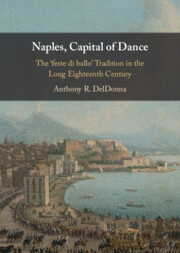Book contents
- Naples, Capital of Dance
- Naples, Capital of Dance
- Copyright page
- Dedication
- Contents
- Figures
- Tables
- Music Examples
- Acknowledgments
- Introduction
- 1 Celebratory Balls in the Kingdom of Naples
- 2 The Politics of Place and Spheres of Power
- 3 Seasons of Feste 1737 and 1747
- 4 The Dance Treatise in the Age of Reason
- 5 Seasons of Splendor
- 6 A Return to the Capital
- 7 Behind the Scenes, Between the Lines
- 8 The Neapolitan feste di ballo as (Historical) Soundscape
- Select Bibliography
- Index
4 - The Dance Treatise in the Age of Reason
Published online by Cambridge University Press: 10 April 2025
- Naples, Capital of Dance
- Naples, Capital of Dance
- Copyright page
- Dedication
- Contents
- Figures
- Tables
- Music Examples
- Acknowledgments
- Introduction
- 1 Celebratory Balls in the Kingdom of Naples
- 2 The Politics of Place and Spheres of Power
- 3 Seasons of Feste 1737 and 1747
- 4 The Dance Treatise in the Age of Reason
- 5 Seasons of Splendor
- 6 A Return to the Capital
- 7 Behind the Scenes, Between the Lines
- 8 The Neapolitan feste di ballo as (Historical) Soundscape
- Select Bibliography
- Index
Summary
Chapter 4 focuses on treatises by Giambattista Dufort, Il Trattato del Ballo Nobile (1728), and Gennaro Magri, Trattato teorico-prattico di ballo (1779). Given the intentionally didactic nature of Dufort’s treatise and its concentration on the minuet, the presentation of the fundamentals, mechanics of the genre, and how to execute the mandatory steps are the primary points for discussion. Magri’s later treatise is a much broader reflection on the contemporary dance environment of Naples (including ample reference to the pantomime and grottesco traditions), and it mirrors the preference for the contradance that emerged in the latter part of the century. Accordingly, Magri concentrates on this more intricate social dance, not only providing the reader with detailed explanations of its content but also devising specific graphic notation paired to original music. This approach provides unprecedented insight into contemporary social dancing and its place within the aristocratic culture of Naples. Given Magri’s career as a primo ballerino in the grottesco tradition, the narrative references ongoing polemics with Charles LePicq (student of Noverre and principal exponent of pantomime style). Finally, Magri’s role at the royal festivities in the capital city and in Caserta is considered.
Keywords
- Type
- Chapter
- Information
- Naples, Capital of DanceThe ‘feste di ballo' Tradition in the Long Eighteenth Century, pp. 75 - 94Publisher: Cambridge University PressPrint publication year: 2025

